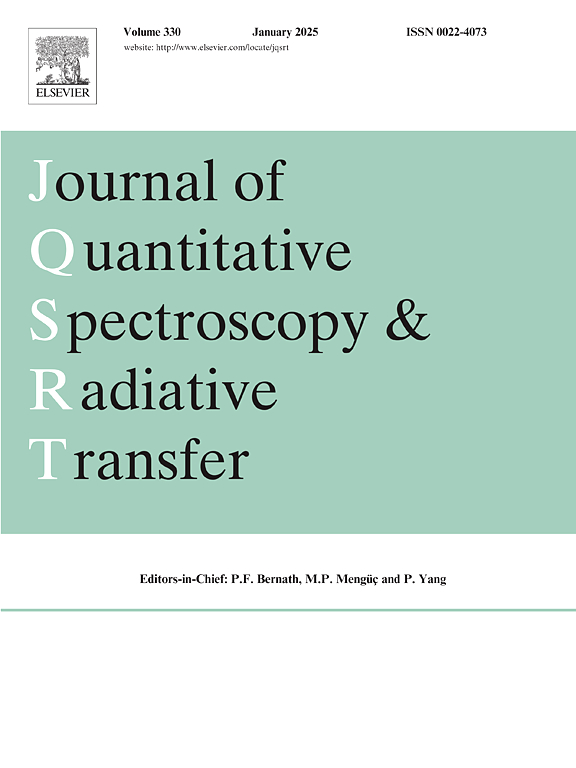荣耀现象及其对金星大气中气溶胶微物理的限制
IF 2.3
3区 物理与天体物理
Q2 OPTICS
Journal of Quantitative Spectroscopy & Radiative Transfer
Pub Date : 2025-05-28
DOI:10.1016/j.jqsrt.2025.109522
引用次数: 0
摘要
本文以金星在λ = 0.365 μm处的光度观测为例,研究了硫酸液滴的大小分布与后向散射相函数上的光涌现象之间的相互关系。我们利用Lorenz-Mie理论计算了半径为r = 0.01 μm到7.5 μm的单球的光散射,并对该多分散粒子体系应用幂律尺寸分布ñ(r)∝r-n。我们的模型显示,当幂律尺寸分布的下限设置足够小(rmin≤0.1 μm)时,光散射响应对幂律尺寸分布的底限的依赖性较弱。极限值rmax与光斑相角位置之间有直接的相互关系,可以很容易地用多项式参数化。由此产生的相互关系可用于通过对金星辉煌现象的观测,立即检索金星大气中气溶胶的最大有效值。我们还表明,与后向散射峰相比,荣耀峰的激增有助于远程识别水和硫酸滴之间的化学成分。本文章由计算机程序翻译,如有差异,请以英文原文为准。
Phenomenon of glory and constraints it places on microphysics of aerosols in the atmosphere of Venus
We investigate the interrelation between the size distribution of sulfuric-acid droplets and the phenomenon of the glory surge on the phase function near backscattering, with special emphasis on photometric observations of Venus at λ = 0.365 μm. We use the Lorenz-Mie theory to compute light scattering by single spheres with a radius spanning the range from r = 0.01 μm up to 7.5 μm and apply a power-law size distribution ñ(r) ∝ r-n to this polydisperse particle system. Our modeling reveals a weak dependence of the light-scattering response on the bottom limit of the power-law size distribution when it is set to be sufficiently small, rmin ≤ 0.1 μm. There is a straightforward interrelation between the upper limit rmax and the phase-angle location of the glory, which can be easily parameterized with a polynomial. The resulting interrelation can be used for immediate retrievals of rmax of aerosols in the atmosphere of Venus using observations of its glory phenomenon. We also show that the surge of the glory compared to that of the backscattering peak helps identify the chemical composition between water and sulfuric acid droplets remotely.
求助全文
通过发布文献求助,成功后即可免费获取论文全文。
去求助
来源期刊
CiteScore
5.30
自引率
21.70%
发文量
273
审稿时长
58 days
期刊介绍:
Papers with the following subject areas are suitable for publication in the Journal of Quantitative Spectroscopy and Radiative Transfer:
- Theoretical and experimental aspects of the spectra of atoms, molecules, ions, and plasmas.
- Spectral lineshape studies including models and computational algorithms.
- Atmospheric spectroscopy.
- Theoretical and experimental aspects of light scattering.
- Application of light scattering in particle characterization and remote sensing.
- Application of light scattering in biological sciences and medicine.
- Radiative transfer in absorbing, emitting, and scattering media.
- Radiative transfer in stochastic media.

 求助内容:
求助内容: 应助结果提醒方式:
应助结果提醒方式:


